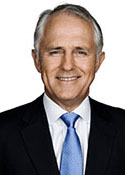Wentworth
Margin: Liberal 18.3%
Region: Eastern Sydney, New South Wales
In a nutshell: The historic blue-ribbon Sydney seat of Wentworth was starting to look dicey for the Liberals at the time Malcolm Turnbull came to it in 2004, but he has since built up a formidable margin.
Candidates in ballot paper order

|
DEJAY TOBOREK PETER XING ANTHONY MICHAEL ACKROYD BERESFORD THOMAS DAVID ALLEN MALCOLM TURNBULL EVAN HUGHES MARC AUSSIE-STONE |
Malcolm Turnbull’s electorate of Wentworth encompasses the southern side of the mouth of Sydney Harbour, including the harbour shore from Vaucluse to Potts Point, a stretch of coast running south through Bondi to Clovelly, and the northern part of Randwick. The redistribution has caused it lose 13,000 voters in Woolloomooloo, Potts Point and Darlinghurst to the Sydney electorate, resulting in a slight boost in the Liberal margin from 17.7% to 18.3%. The wealth of the harbourside suburbs have long made it a blue-ribbon seat, with conservatives of one kind or another holding it since it was created at federation. Former members have included Robert Ellicott (1974 to 1981), the Shadow Attorney-General who played a crucial tactical role in the 1975 supply crisis; Peter Coleman (1981 to 1987), conservative intellectual and father-in-law of Peter Costello; and John Hewson (1987 to 1996), federal Opposition Leader from 1990 to 1994. Hewson’s departure in 1995 marked the start of a turbulent period in which two successive members, Andrew Thomson and Peter King, were deposed in preselection challenges. King lasted one term after unseating Andrew Thomson at the 2001 election, before running into the juggernaut of Malcolm Turnbull in 2004.
Turnbull had been spoken of as a potential prime minister since coming to fame as a young lawyer in the early 1980s, when he succeeded in blocking the British government’s attempts to suppress former MI5 agent Peter Wright’s memoirs in the Spycatcher trial. His profile rose still further when he chaired the Australian Republican Movement leading into the 1999 referendum. In the meantime, he made his fortune firstly in legal partnership with Nicholas Whitlam, son of Gough Whitlam, and later as a merchant banker. His move against Peter King in 2004 won at least tacit support from John Howard, despite any lingering resentment over their hostilities during the republic campaign. After a vigorous local party recruitment war, Turnbull prevailed in the preselection vote by 88 votes to 70. King attempted to retain the seat at the election as an independent, but finished well behind Labor in third place with 18.0% of the vote.
Turnbull’s parliamentary career began with two years of dues-paying as a back bencher and parliamentary secretary, before he was promoted to cabinet as Environment and Water Minister in January 2007. Peter Costello’s decision not to contest the leadership after the 2007 election defeat had many expecting the position would go to Turnbull, but Brendan Nelson defeated him in the party room vote by 45 votes to 42. He instead served as Shadow Treasurer until September 2008, when he toppled Nelson in a leadership challenge by 45 votes to 41. Turnbull’s first tenure as Liberal leader lasted 15 months, before his determination to support the Rudd government’s emissions trading scheme provoked a party revolt. A leadership vote on December 1, 2009 pitted both Tony Abbott and Joe Hockey against Turnbull, with the former prevailing by 42 votes to 41 after the latter unexpectedly finished third.
Turnbull returned to the back bench after his defeat and announced he would not seek re-election the following April, but he reversed the decision less than a month later. After the 2010 election he returned to the front bench as Shadow Communications Minister, and retained the portfolio when the Abbott government came to power in September 2013. This gave him oversight of the National Broadband Network rollout amid a progressively deteriorating political environment for Tony Abbott and his government. Turnbull indicated that he might put his name forward for the leadership if the spill motion against Tony Abbott in February 2015 succeeded, but it fell short of doing so by a margin of 61 votes to 39. However, momentum continued to gather behind Turnbull as the Coalition’s polling worsened again towards the middle of the year, and on September 14 he defeated Abbott in a leadership ballot by 54 votes to 44.
Turnbull’s political successes have been reflected in his strong electoral performance in Wentworth, a seat that might otherwise have developed into a problem for the Liberals. The margin slipped from 7.9% to 5.5% amid the discord that surrounded Turnbull’s preselection putsch in 2004, and it was then pared back a further 2.9% by a redistribution that added territory at the city end. However, Turnbull went on to enjoy the only swing against Labor of any Coalition candidate outside of Western Australia in 2007, and he has since emphatically secured his hold with successive swings of 10.9% in 2010 and 2.9% in 2013.
 Four weeks into the campaign, Labor candidate Evan Hughes provided Fairfax with results of a ReachTEL poll he commissioned showing a 10% swing against Turnbull, reducing the margin from 18% to 8%. The poll was conducted July 2 from a sample of 626.
Four weeks into the campaign, Labor candidate Evan Hughes provided Fairfax with results of a ReachTEL poll he commissioned showing a 10% swing against Turnbull, reducing the margin from 18% to 8%. The poll was conducted July 2 from a sample of 626.
Analysis by William Bowe. Read William’s blog, The Poll Bludger.


